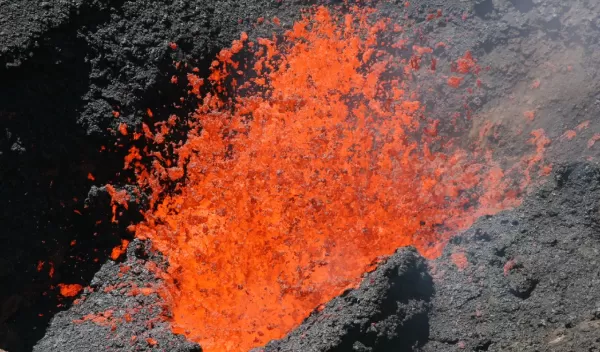
Listen to the pulse of an erupting volcano: Chile's Villarrica
Find related stories on NSF's geosciences risk and resilience interest area at this link.
Rucapillan--house of the spirit--it's called by indigenous Chileans known as the Mapuche. And what a spirit it has, this volcano in south-central Chile that's perhaps best known as Villarrica.
The volcano, one of Chile's most active, rises above a lake and town of the same name 470 miles south of Santiago. Villarrica is the westernmost of three large volcanoes that run perpendicular to the Andean mountain chain.
Along with Quetrupillan and the Chilean part of Lanin, Villarrica is protected in Villarrica National Park. The scene is usually tranquil, allowing guided ascents to Villarrica's summit, magnets for tourists from around the world.
Villarrica: far from quiet
But all in Villarrica National Park is not as it seems.
At 3 a.m. on March 3, 2015, Villarrica blew its top in a spectacular fire fountain. Its fit of temper was short-lived, but prompted evacuations of nearby communities and the establishment of a six-mile-radius exclusion zone.
After the fire and lava subsided, volcanic mudflows, or lahars, followed.
In the midst of it all was geologist Jeff Johnson of Boise State University.
Johnson is funded by the National Science Foundation (NSF) to research what's called infrasound, the low-frequency and inaudible-to-human tones volcanoes produce. Some are akin to blood flowing through a human body.
"Based on the characteristics of sound waves transmitted through the atmosphere, scientists can monitor and study the evolution of volcanoes right up until eruptions--and from a safe distance," says program director Chungu Lu of NSF's Division of Atmospheric and Geospace Sciences, which co-funded the research with NSF's Division of Earth Sciences.
Understates Johnson, "The capricious behavior of volcanoes can lead to many opportunities for new discoveries."
Normal life blown sky-high
Until the end of January, Johnson says, "everything was pretty much normal." He was able to set up infrasound instruments--monitors that listen to the sounds a rumbling volcano makes--on Villarrica's rim. Johnson has been conducting a study of the "passive activity" of the lava lake at the center of the volcano's crater.
By early February, however, the placid picture had begun to change.
"The volcano started throwing 'bombs' of lava up and over the crater," says Johnson. Villarrica's rim was closed.
Then Villarrica went quiet. Sometimes. "Every so often it would heave incandescent balls of fire into the air," says Johnson. At night, the fireballs were visible from miles away.
Then on March 1st everything went downhill. Larger explosions happened. The next day, a red alert was declared by Chilean authorities.
"The warning proved extremely timely," says Johnson. "The volcano had entered a new phase of paroxysmal activity, including a 1,000-foot-high fire plume that 'fountained' upward."
Ringside seat
March 3rd, 3 a.m. "The view from my house, which is relatively nearby, was of a fire fountain streaming upward from the summit," recalls Johnson. "It was spectacularly visible--from 10 miles away."
His first priority was to awaken his kids in case his family needed to move to an evacuation zone. Some 5,000 people were temporarily evacuated. Shops and schools were closed.
"My second priority was to set up cameras to chronicle the eruption and compare it to the infrasound installations deployed across the region," Johnson says.
By the next day, the eruption was over.
Show is far from done
If history is any indicator, however, Villarrica is far from finished.
Many Villarrica eruptive periods, including that of 1971 and 1984-85, began with explosions over the course of several months. Not far behind were lava flows.
Records of Villarrica eruptions preserved in lake sediments over the past 600 years show an average of 22 years of "repose" between awakenings. Then, explosions again.
"Clearly this volcano remains a very real hazard," says Johnson. "The red alert has been lifted, but it's more likely than not that activity will resume. Locals continue to be uneasy."
The sound of a volcano
Johnson had deployed eight infrasound instruments near the volcano's crater. Now they're gone, sacrificed to Villarrica. Another 22 instruments, placed farther from the summit, survived the eruption and recorded a unique data set.
"Serendipity is science's best friend," says Sonia Esperanca, program director in NSF's Division of Earth Sciences. "It's as if Villarrica waited for the instruments to be deployed before it decided to show its colors."
What did the infrasound instruments hear?
Gases bubbling, explosions and the back-and-forth movements of magma: Villarrica's erratic circulation. "'Popcorn' noises, which were the explosions, were followed by the roar of the fire fountain, then by movement, which was the lahar mudflow," says Johnson.
The infrasound measurements he obtained during Villarrica's eruption are a sequence: a volcano as it evolves from a passive vent with a stable lava lake, to one with heightened activity that increased over a few weeks--and ended in dramatic fire.
The information tells a story of an explosive event that at its peak lasted approximately 30 minutes. Then Villarrica went back to sleep, its crater filled with a pool of slowly cooling lava.
"Now I have a new science opportunity," says an intrepid Johnson, "to use infrasound to understand how a 'passive' volcano transitions to a sustained explosive eruption."
Villarrica is returning to normal. On the surface. "What's happening beneath," says Johnson, "is anyone's guess."
